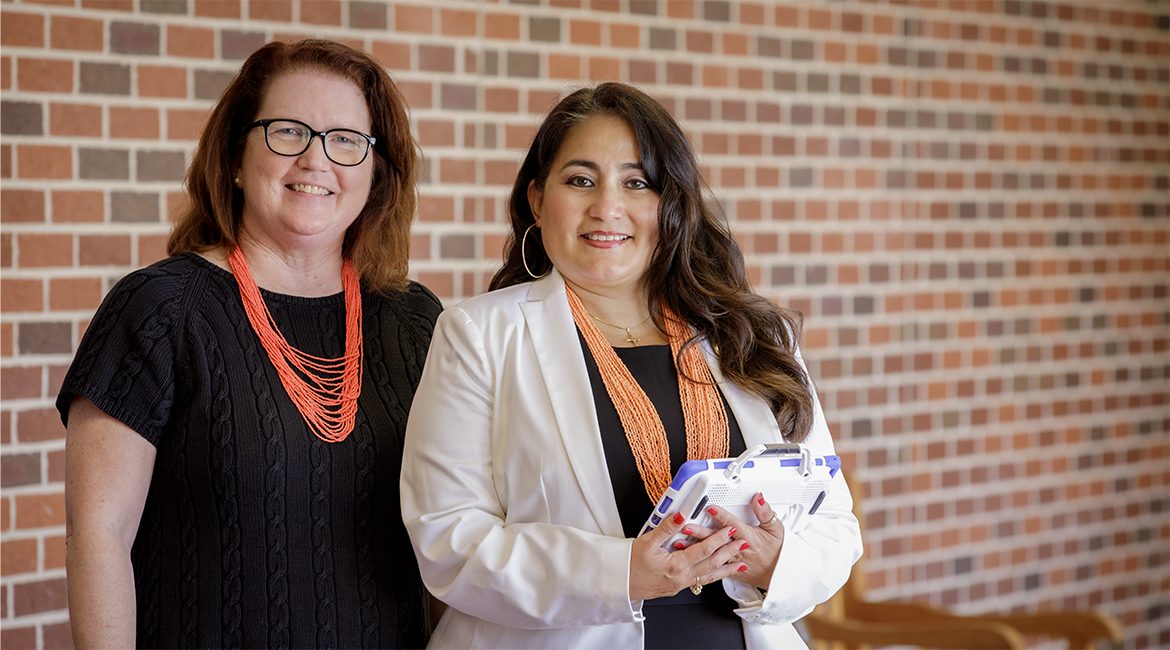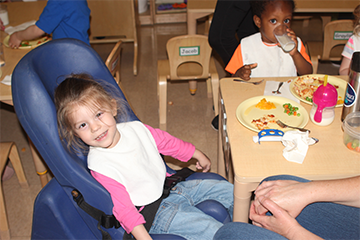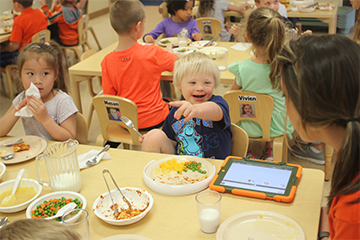
Giving voice to the quietest
Wednesday, October 23, 2019
Best friends and Oklahoma State University colleagues Dr. Gretchen Cole-Lade and Dr. Claudia Otto have spent the last three years supporting and empowering children who have complex communication needs and varying degrees of disabilities using assistive technology.
“She is a quantitative researcher, and I’m a qualitative researcher,” Cole-Lade said. “It was a natural fit and balance.”
Cole-Lade, an assistant professor of human development and family science in the College of Human Sciences, and Otto, an assistant professor of special education in the College of Education, Health and Aviation, met while completing their doctorates at OSU. Both had a passion for helping students with special needs, and both recognized an opportunity to leverage their resources and expertise.
“As a special education teacher, you cannot accomplish your goals and help students unless you have partnerships and collaboration,” Otto said. “It’s a pivotal part of our work. Disabilities stem from so many strengths, weaknesses, personalities and characteristics. It’s not possible for one person to see and address all of those.”
In 2016, Cole-Lade and Otto formed an interdisciplinary research team to study how technological communication support can help increase the independence of young children living with disabilities. Eight children, ages 2 to 7 with cerebral palsy, Down syndrome, developmental delays, sensory impairments and other intellectual disabilities, were introduced to low- and high-tech devices and software in their classrooms.

They learned how to use the devices and software to assist them with communicating and performing daily tasks. The project, funded by the Bartlett Family Grant, included team members from Oklahoma ABLE Tech, the OSU Child Development Laboratory and the OSU College of Arts and Sciences.
“The most challenging part was creating buy-in,” said Cole-Lade. “Of course, our team had already bought in, and we were all excited. Getting all of the educational professionals and parents on board was the hard part. We had to get them to buy in to the power of the device, always remembering that these are parents with hopes and to respect and support that.
”Initially, Cole-Lade and Otto conducted interviews and met individually with teachers and parents. From there, they observed students in their classrooms in the OSU Child Development Lab and Stillwater Public Schools, and examined how following steps identified by the Quality Indicators for Assistive Technology (QIAT) impacted the children’s successful use of assistive technology to communicate. The study used speech generating devices and iPads equipped with programs such as Language Acquisition through Motor Planning (LAMP) and Snap Scene, an instant scene-based communication and learning application.
“We had one little one who started with us when he was 3,” Cole-Lade said. “He was diagnosed with a developmental delay and had a lot of sensory issues, including some characteristics of autism, but not diagnosed. He was completely non-verbal when we started working with him, and he was pretty frustrated with not being able to communicate his needs. We started him on the Accent 800, a high-tech communication device. Within two years, he was speaking and spelling. He was our rock star.”
The study found that students with disabilities do initiate purposeful communication, and they react more to environmental circumstances when using assistive technology devices. These students have something to say, and they want to say it.
“Yes, we are trying to provide assistive technology and training for these students so they can have a voice, but it’s also about discovering what that voice means to them,” Otto stressed. “There was a little girl who wasn’t able to feed herself. Once she discovered her voice, we realized she wasn’t eating how she preferred. She had a certain order she wanted to eat her food —she liked to eat all her veggies first and then the meat and then the fruit. If you think about it, we all have a set way we like to enjoy our meal, and she was eating the way someone else had decided. Being able to finally communicate her preferences —that’s true membership, true independence. That’s her enjoying her life now, not just surviving it.”

The project far exceeded expectations, and both Cole-Lade and Otto light up when discussing the impact of the study.
“My cheeks hurt from smiling when I talk about it,” Cole-Lade beamed.
It’s been a heartfelt journey for all those involved, especially for the parents who have watched their children thrive with the help of assistive technology.
“I feel that it has given him a sense of independence when communicating with friends and teachers at school, and it has alleviated some frustration of not being able to do so,” said Gretchen Howell, whose son, Graham, participated in the study all three years. “I was apprehensive at first about his use of a communication device; I felt that it may become a crutch or an excuse to not speak for himself. It has done the opposite — it has given him the motivation and confidence to initiate speech more than he ever has before.”
BJ, a participant with developmental delays and complex communication needs who joined the study in the last year, now lights up when given the opportunity to tell someone his name and age.
“We are looking forward to the new school year and expect to see even more improvement with increased opportunities to use the iPad,” said Eillo Pannell, BJ’s mother. “We believe this will greatly increase his independence and decrease his anxiety.”
Formal data collection and grant funding for the study ended this year, but Cole-Lade and Otto are not done yet. They plan to stay involved with the project and periodically touch base with those using the devices, including Graham and BJ.
“We are looking for other funding because we can still continue and grow this,” Otto said. “I’m looking at connections with other community research projects. I don’t want to stop. There’s more work to be done.”
Regardless of what the future holds, this faculty duo remains committed to helping others navigate and overcome life’s obstacles.
“All of our struggles, disability or not, make us the beautiful people we are,” Otto said.
